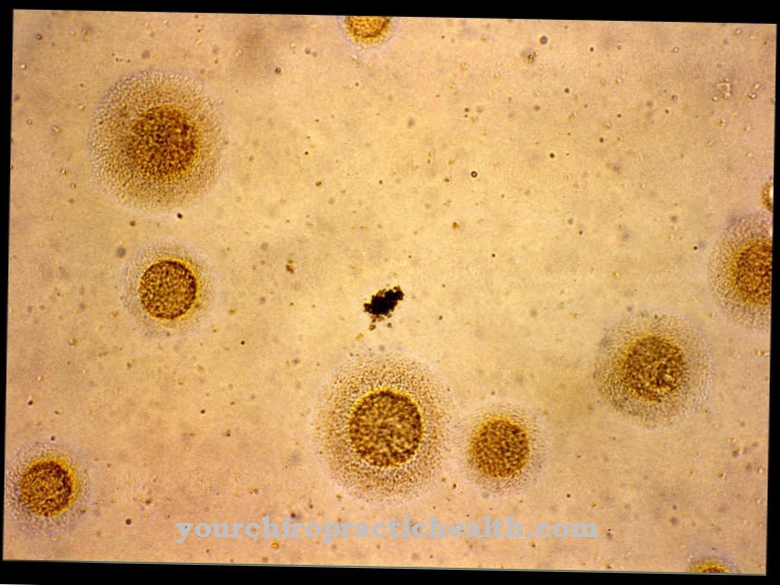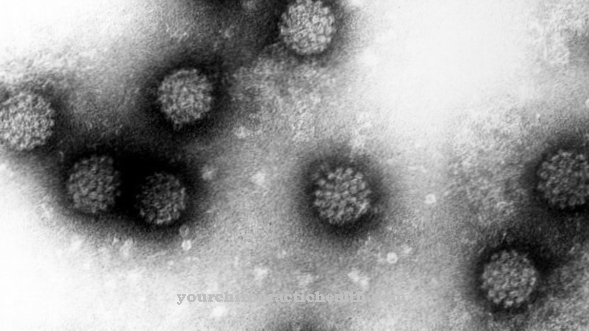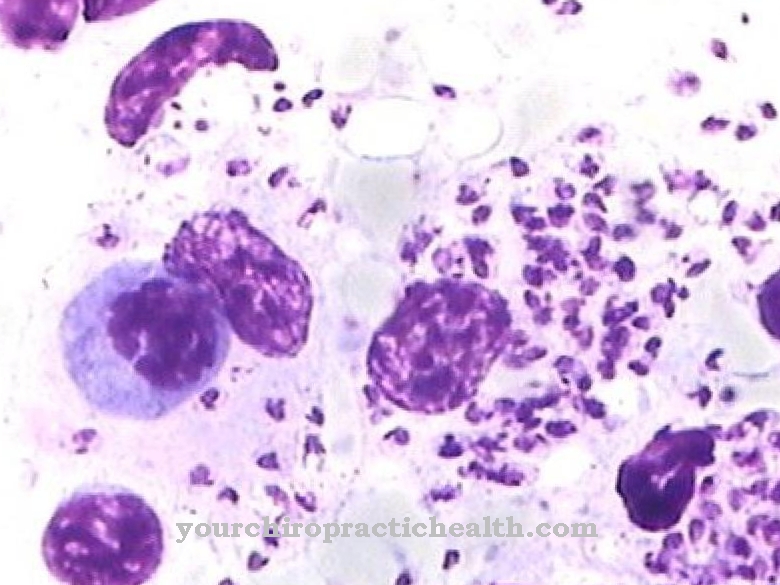Pseudomonas aeruginosa is a bacterium of the order Pseudomonadales. The pathogen can be pathogenic to humans. It is best known as a nosocomial germ.
What is Pseudomonas aeruginosa?
Pseudomonas aeruginosa is a rod bacterium of the genus Pseudomonas. The pathogen was discovered in 1900 by the German botanist Walter Emil Friedrich August Migula. Pseudomonas aeruginosa owes its name to the blue-greenish pus coloration that occurs when the pathogen is infected. Despite the early discovery in 1900, the bacterium's genome could not be fully sequenced until 2000. It is 6.3 Mbp in size and consists of more than 5500 genes.
Pseudomonas aeruginosa is a gram negative bacterium. Gram-negative bacteria can be stained red in the Gram stain. In contrast to the gram-positive bacteria, they not only have a thin layer of peptidoglycan made of murein, but also an outer cell membrane. This difference plays a role in the treatment. Gram-positive pathogens are treated with different antibiotics than gram-negative pathogens.
Pseudomonas aeruginosa is an obligate aerobic bacterium. So it depends on oxygen. In terms of external living conditions, Pseudomonas aeruginosa is extremely undemanding. The bacterium can survive for a long time in both wet and dry conditions. Typically, however, Pseudomonas aeruginosa prefers humid environments.
Occurrence, Distribution & Properties
Pseudomonas aeruginosa is one of the nosocomial germs. Nosocomial infections are infections that occur during a hospital stay or during outpatient treatment. The bacterium is widespread in nature. It lives in the ground or in water and prefers moist environments. The germ can therefore be found on damp floors, in surface water, in tap water, in showers, toilets, dishwashers or wash basins. Medicines, dialysis machines or even disinfectants can also be contaminated with Pseudomonas aeruginosa. The germ can even survive in distilled water. The prerequisite is, however, that small amounts of organic substances are present in the substance concerned. In hospitals, Pseudomonas aeruginosa can also be found on ventilation tubes, in humidifiers and incubators or in soap containers. Flower vases are also often contaminated.
The infection with the pathogen occurs through direct contact. An infection is favored by a weakened immune system. There is an increased risk of infection for patients with skin or mucous membrane defects. Pseudomonas aeruginosa is highly pathogenic. This considerable pathogenicity can be attributed to various virulence factors.
Illnesses & ailments
The bacteria attach themselves to their target cells through so-called fimbriae. Fimbriae are thread-like adhesins that enable bacteria to adhere to epithelial cells. The bacteria release exotoxins and enzymes such as alkaline protease or elastase at the target cell. In interaction with various hemolysins, which are also released, the cells and tissue are damaged by the bacteria. Since Pseudomonas aeruginosa have bacterial lipopolysaccharides on their surface, the immune system cannot opsonize them. In this way, the bacteria are not recognized by the phagocytes and, accordingly, are only attacked late by the immune system.
Pseudomonas aeruginosa is one of the most common causes of hospital infections. Around 10 percent of all nosocomial infections are due to Pseudomonas aeruginosa. Pseudomonas aeruginosa can cause pneumonia, particularly in patients with cystic fibrosis or in intensive care units. The inflammation of lung tissue is called pneumonia. Inflammation causes inflammatory fluid (exudate) to accumulate in the alveoli. This leads to a reduction in lung function and thus to shortness of breath. The patient's breathing rate increases. In addition, there is a fever and cough.
A urinary tract infection often develops in patients who have had a permanent urinary catheter or who have had urological surgery. Typical symptoms are pain and burning when urinating, frequent urination with small amounts of urine, or the urge to urinate without urinating. In the case of infections of the upper urinary tract, for example inflammation of the kidney pelvis, fever and pain in the kidney bed can occur.
In the case of skin defects, Pseudomonas aeruginosa can cause skin infections. Burn victims are often affected here. The green-blue pus is typical of skin infections with Pseudomonas aeruginosa. Other symptoms of a skin infection with Pseudomonas aeruginosa include a rash and blistering.
Newborns can also become infected with Pseudomonas aeruginosa in hospital. Your immune system is not yet fully developed, so the infections can take a drastic course. Newborn sepsis can develop, especially in premature babies or in newborns with a low birth weight. It is a blood poisoning that is associated with shortness of breath, blue skin, bleeding into the skin, cramps and drowsiness. In the worst case, septic shock can develop. This is usually fatal for the newborn.
Other neonatal manifestations are meningitis (meningitis) and pneumonia (pneumonia). A typical place of manifestation of Pseudomonas aeruginosa is also the outer ear. Here the pathogen causes otitis externa. This is also known as the "swimmer's ear". In otitis externa, the skin and subcutaneous tissue in the area of the external ear canal are inflamed. A middle ear infection (otitis media) can also be caused by Pseudomonas aeruginosa.
In the absence of or incorrect treatment, sepsis is to be feared for every infection with Pseudomonas aeruginosa. Treatment is usually with antibiotics. Since Pseudomonas aeruginosa can form so-called ß-lactamases, most cephalosporins and penicillins are ineffective. The pathogen has developed antibiotic resistance here. Instead, ceftazidime, piperacillin and quinolones are used.



























